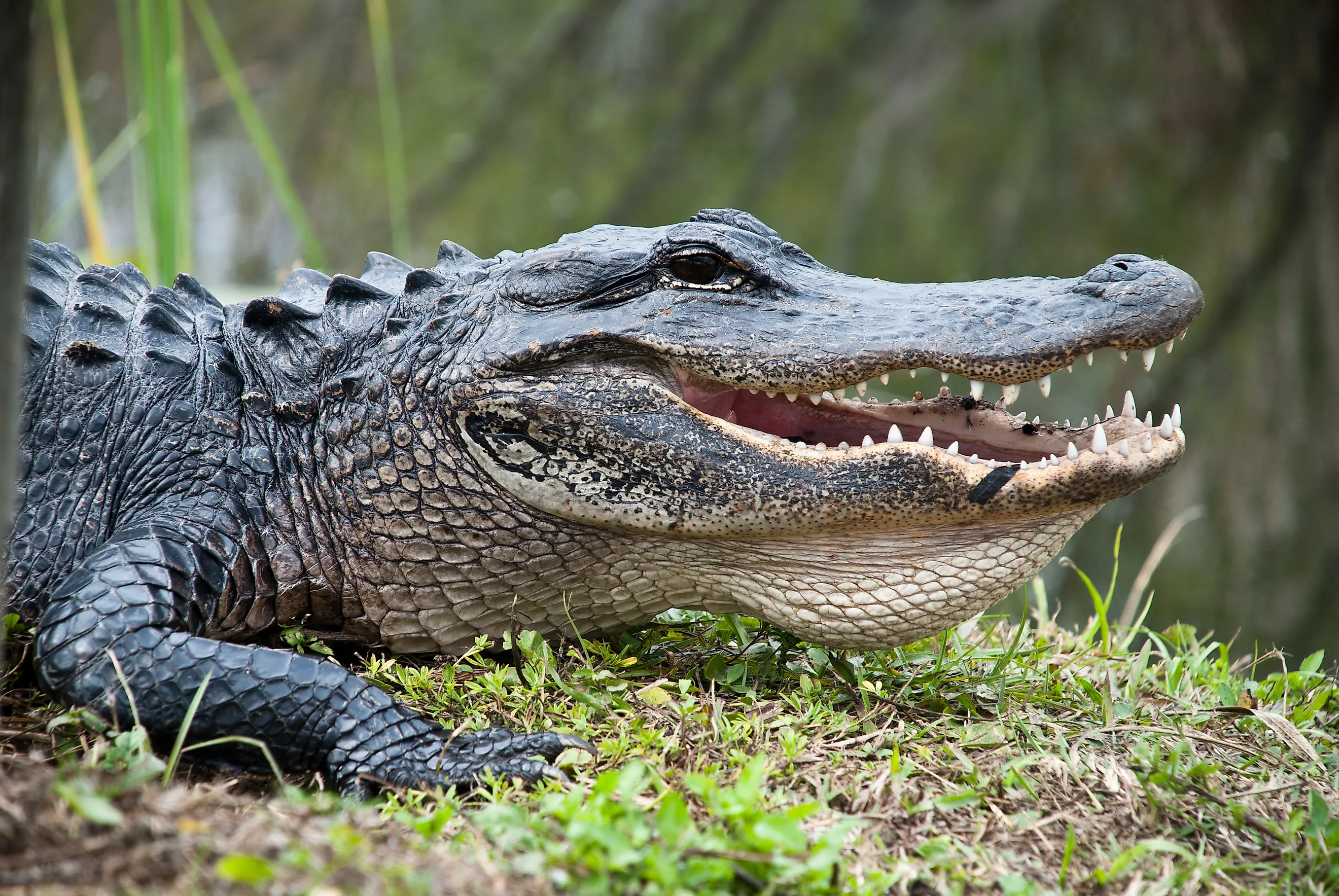
Animals Of The Florida Everglades
The Florida Everglades is a shallow, slow-moving sheet of water that flows from Lake Okeechobee to Florida Bay. Its habitats, saw-grass marsh, mangrove swamp, cypress dome, and pine rockland, support one of North America’s greatest concentrations of wildlife.
More than 350 bird species, 300 fish, 50 reptiles, and 40 mammals survive here, among them 36 federally listed species such as the Florida panther, American crocodile, and West Indian manatee. Alligators maintain 'gator holes' that keep water and fish available during droughts; nesting herons rely on these openings. Small fish recycle nutrients that drive the marsh’s productivity.
The system depends on a natural pulse of freshwater now disrupted by canals, invasive Burmese pythons, and accelerating sea-level rise. The following sections examine the key animal groups that still define this imperiled wetland. Their future hinges on decisive restoration efforts. Recovery is possible through sound science and public support.
Jump to information about invasive animal species in the Florida Everglades
Mammals
Florida Panther
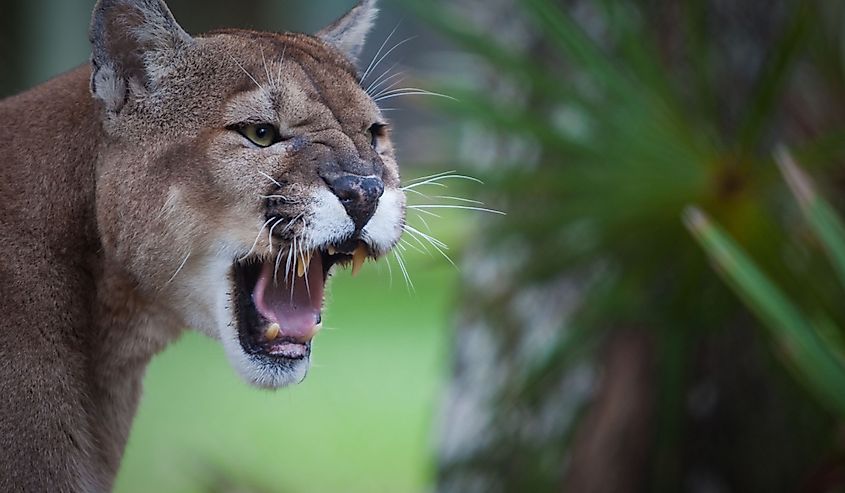
Slipping like a tawny shadow through sawgrass and cypress, the Florida panther (Puma concolor coryi) is the Everglades’ elusive apex predator. Fewer than 200 remain, survivors of habitat loss, road collisions, and genetic bottlenecks. Adaptive to swamps, they prowl at dawn and dusk, preying on white-tailed deer, wild hogs, raccoons, and even alligators. Males patrol ranges up to 200 square miles, while females den in dense palmetto thickets to raise spotted kittens. Conservation corridors, wildlife underpasses, and genetic augmentation with Texas cougars have nudged numbers upward. Protecting this charismatic feline safeguards an entire wetland ecosystem for future generations to cherish.
Florida Black Bear
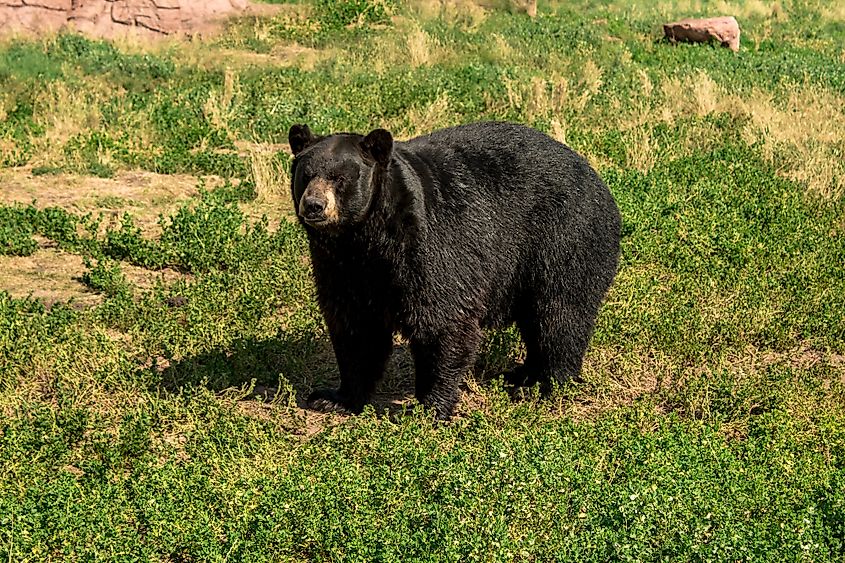
Florida’s black bear, a subspecies of the American black bear, roams the Everglades’ pinelands, hardwood hammocks, and wet prairies with surprising stealth. Cloaked in glossy midnight fur and weighing up to 400 pounds, it forages on saw palmetto berries, acorns, insects, and the occasional armadillo. Bears mark vast home ranges with clawed trees and footpaths worn into the marl. Winter den sites are scraped beneath sabal palms or hollowed stumps, where cubs are born hairless and blind. Protecting habitat linkages and enforcing slow-speed zones reduce deadly vehicle collisions each year.
West Indian Manatee
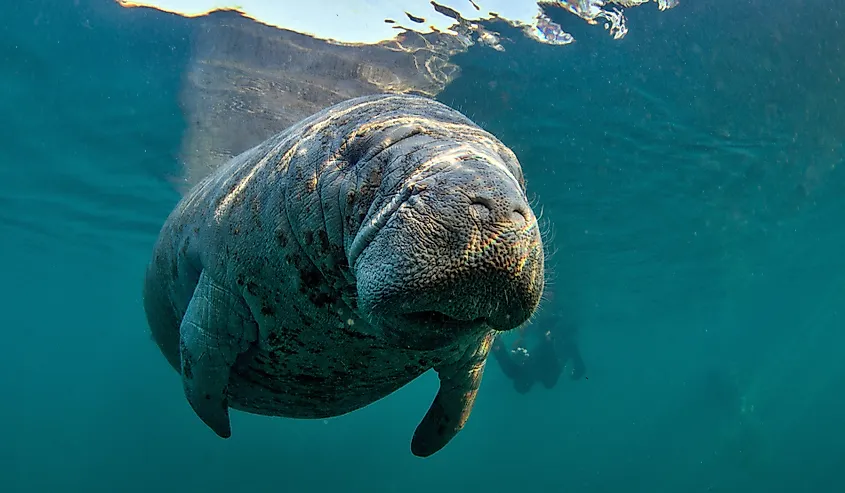
Gliding like a gentle gray blimp through tea-stained rivers and mangrove lagoons, the West Indian manatee (Trichechus manatus latirostris) embodies the Everglades’ tranquil side. These hefty herbivores, averaging 1,000 pounds, browse seagrasses, hydrilla, and water hyacinth for up to eight hours daily, shaping aquatic meadows. Lacking blubber, they congregate at warm springs or power-plant outflows whenever water dips below 68 °F. Slow reproduction, one calf every two to three years, makes the population vulnerable to boat strikes, red-tide toxins, and seagrass die-offs. Enforced idle-speed zones and habitat restoration are critical to keeping Florida’s beloved “sea cows” afloat for generations to marvel at forever.
White-Tailed Deer
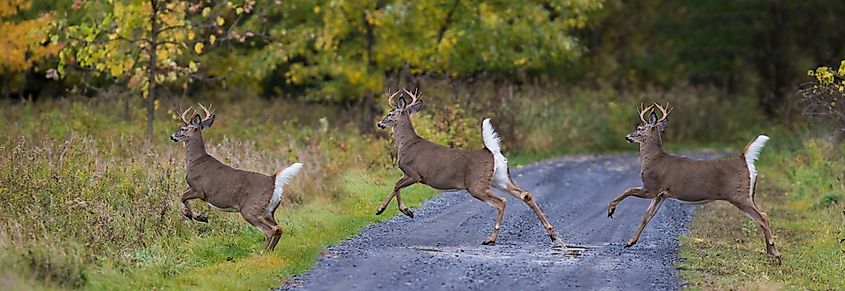
White-tailed deer, the Everglades’ nimble browsers, thread silently among pinelands, prairies, and cypress domes, flashing the eponymous flag of warning when startled. Adults rarely exceed 100 pounds here, an adaptation to sparse nutrition and constant wading. At dawn and dusk they graze sawgrass shoots, pond apple leaves, and tender mangrove seedlings, sculpting plant communities and feeding panthers, bobcats, and alligators. Fawns, speckled for camouflage, spend daylight hidden in ferny hummocks while does forage nearby. Maintaining freshwater flow and predator balance keeps this keystone herbivore thriving. Their story mirrors wetlands' resilience.
Bobcat
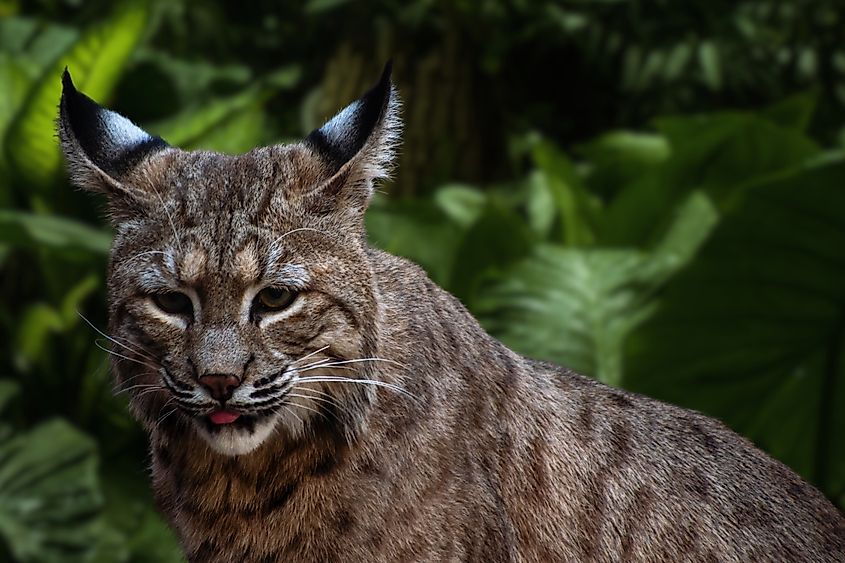
Short, spotted, and superbly agile, the Everglades bobcat (Lynx rufus floridanus) is the region’s versatile mid-level carnivore. About twice the size of a house cat, it prowls pinelands, sawgrass marshes, and mangrove islands with tufted ears swiveling for sound. Dawn and twilight hunts yield rabbits, marsh rats, young raccoons, and ground-nesting birds, keeping prey populations in check. Bobcats swim readily, leap six feet high, and stash surplus kills in Spanish-moss drapes. Kittens born in palmetto dens emerge after two months to learn stalking craft. Protecting upland refuges and reducing road mortality ensures this secretive feline continues stitching wild edges together.
North American River Otter
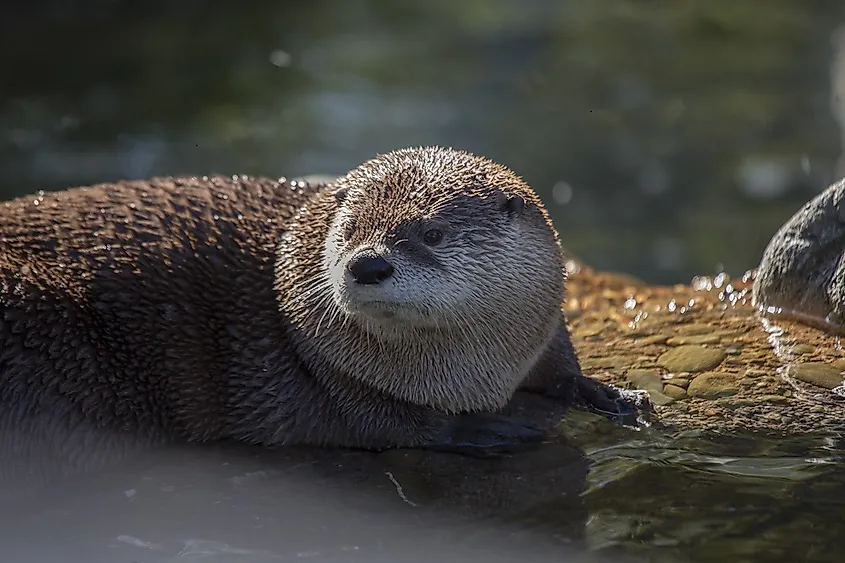
The North American river otter (Lontra canadensis) darts through Everglades sloughs like a living otter-gray torpedo. Dense waterproof fur and webbed feet power underwater chases lasting up to eight minutes, corralling fish, crayfish, and small turtles. On floating tussocks they roll to groom, maintaining fur’s insulating air layer against chilling winter fronts. Family groups of a female and year-old pups slide down muddy banks, their trails called “otter slides.” Clean water is vital; pollutants and mercury in prey threaten populations. Restoring flow from Lake Okeechobee safeguards both their larder and joyful aquatic acrobatics for generations.
Marsh Rabbit
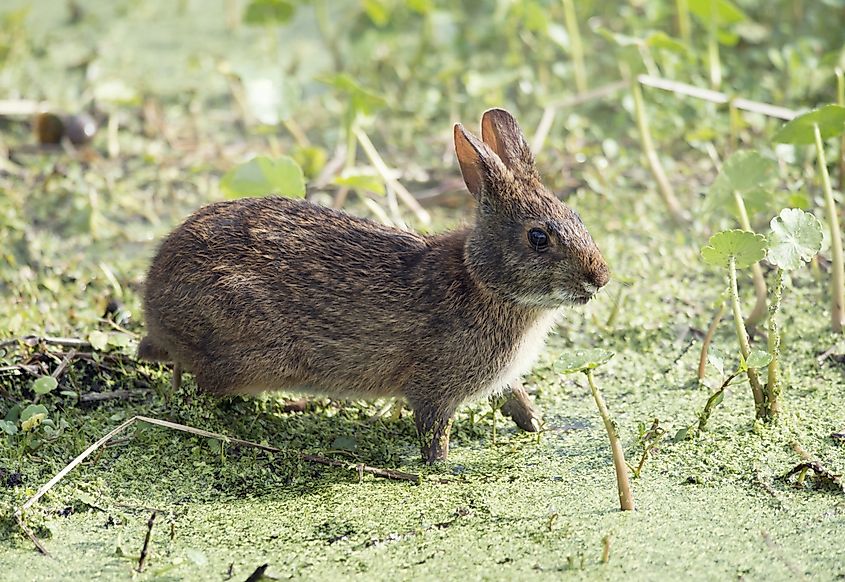
Small, chocolate-brown marsh rabbits (Sylvilagus palustris) weave through sawgrass and cattail thickets like ripples of living peat. Unlike their cottontail cousins, they swim readily, propelling themselves with hind feet to escape fire or hungry gators. Their scant, rusty tail blends with shadowy waterlines, making the flash of white absent. At dusk they nibble maidencane shoots, pickerelweed, and tender mangrove seedlings, recycling nutrients through droppings savored by invertebrates. Females nest atop floating mats, shielding blind kits from floods. Conserving freshwater flow preserves their soggy labyrinth and buttresses the Everglades food web.
Virginia Opossum
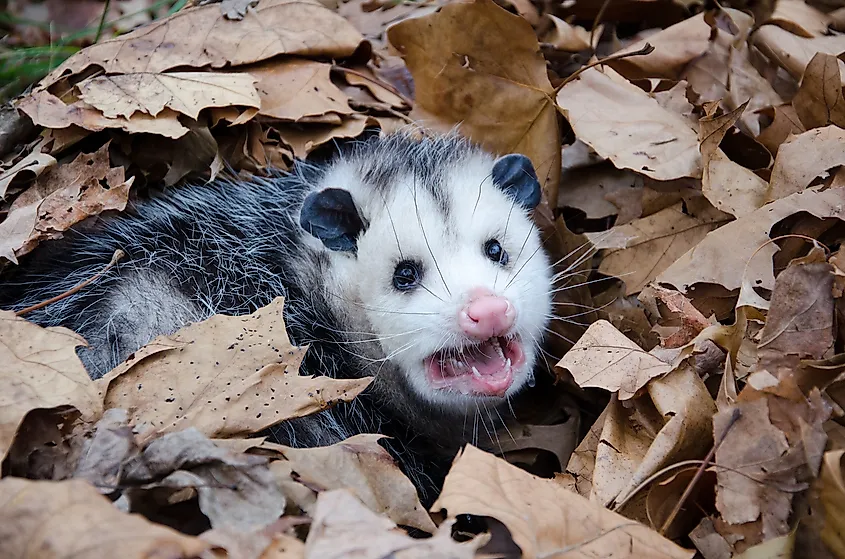
Clad in grizzled gray fur and armed with fifty sharp teeth, the Virginia opossum (Didelphis virginiana) moonlights across the Everglades’ levees, mangrove fringes, and hardwood hammocks. North America’s only marsupial, it totes pink-eared joeys in a pouch, later ferrying them piggyback along boardwalk shadows. Opportunistic menus include snails, fallen citrus, carrion, ticks, and even venomous snakes, to whose toxins it shows remarkable resistance. Prehensile tails aid balance while climbing cabbage palms in search of Spanish-moss nests. When cornered, the opossum collapses into a deathlike stupor, fooling predators. By cleaning refuse and consuming disease-bearing insects, it quietly tidies the wetlands’ nightscape.
Raccoon
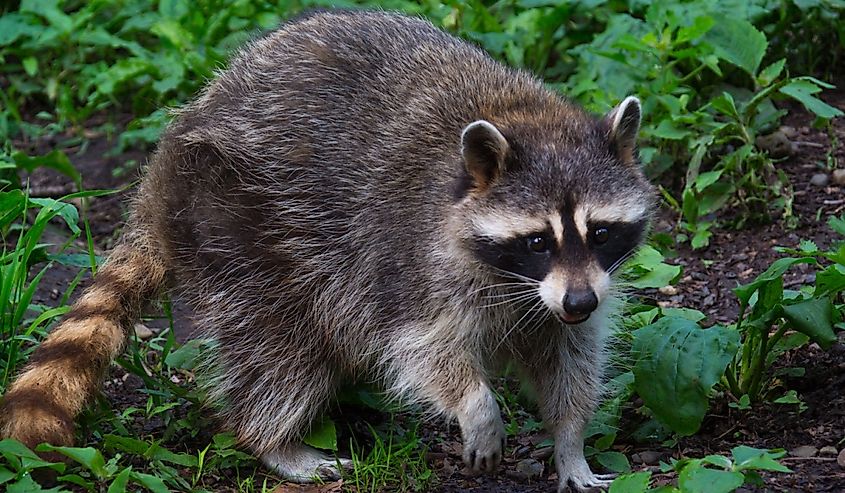
The Everglades raccoon (Procyon lotor), masked in charcoal and ring-tailed finesse, thrives on resourcefulness. It prowls mangrove islands, pinelands, and campground edges, rinsing clams, crabs, and pond apple seeds in moonlit shallows. Dexterous hands pry oyster shells, unlace coolers, and unravel crayfish burrows. Females den in hollow cypress trunks, raising litters that soon mimic her curious foraging. This omnivore’s appetite for turtle eggs draws alligator ire, yet it also disperses seeds through droppings. Maintaining campsite cleanliness and predator balance keeps these clever night wanderers fitting smoothly into the wetland mosaic.
Birds
Wood Stork
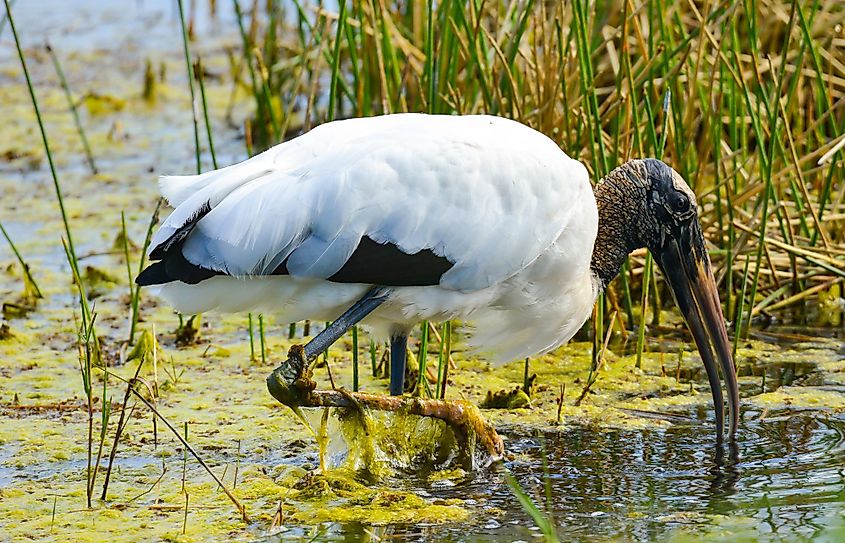
Standing tall on spindly pink legs, the Wood Stork (Mycteria americana) commands Everglades rookeries like a solemn white bishop. Its bald, scaly head belies an extraordinary feeding tactic: snapping shut a sensitive bill in milliseconds when tiny fish brush the mandibles. Successful nesting demands rapid water drawdowns that concentrate prey, so storks time courtship to the dry season and weave stick platforms high in pond apple or cypress canopies. Parents shuttle wriggling minnows to gawky, clattering chicks. Altered hydrology, sea-level rise, and development still jeopardize colonies, yet restoration projects offer hope for this barometer of wetland health into future stewardship.
Roseate Spoonbill
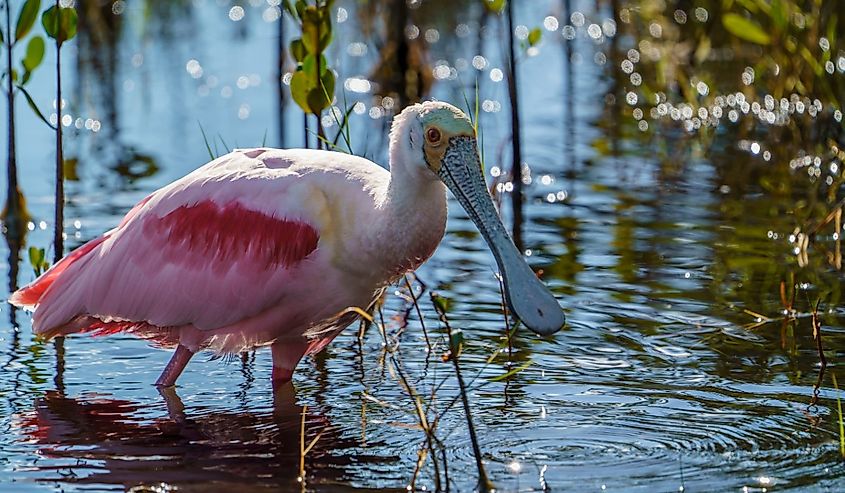
Like a living sunset gliding over glittering flats, the roseate spoonbill (Platalea ajaja) lends flamboyant color to Everglades sloughs and mudflats. Bubble-gum wings arise from carotenoid-rich crustaceans, while the spatulate bill scythes side-to-side, straining shrimp, killifish, and aquatic insects. Flocks fly in single file, bare heads held outstretched, their loud grunts betraying rookery gatherings with herons and storks. Nest platforms of mangrove sticks cradle three white eggs, incubated by both parents in the late dry season. Habitat loss, altered salinity, and mercury contamination imperil colonies, making freshwater restoration critical for this charismatic ambassador of recovering wetlands in South Florida’s expanse.
Great Blue Heron
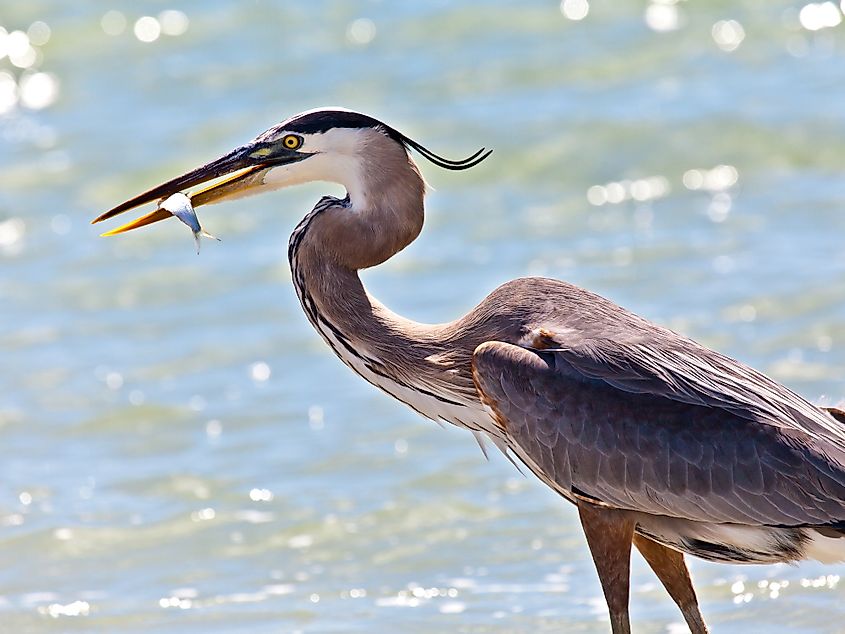
The Great Blue Heron (Ardea herodias) stalks Everglades marshes with patient elegance. Six-foot wings spread like pale denim when it lifts from sawgrass, yet on the hunt it freezes, dagger bill poised above glittering shallows. A sudden strike nets sunfish, mullet, or careless snake, swallowed whole in a shrug of feathers. Nests, bulky stick platforms, cluster in knob cypress crowns, where both parents incubate pale blue eggs through spring’s blistering heat. Adaptive generalists, herons still depend on unpolluted wetlands; rising salinity, plastic ingestion, and disrupted water flows threaten their lanky silhouettes at dusk. Without them, the marsh feels emptier.
Anhinga
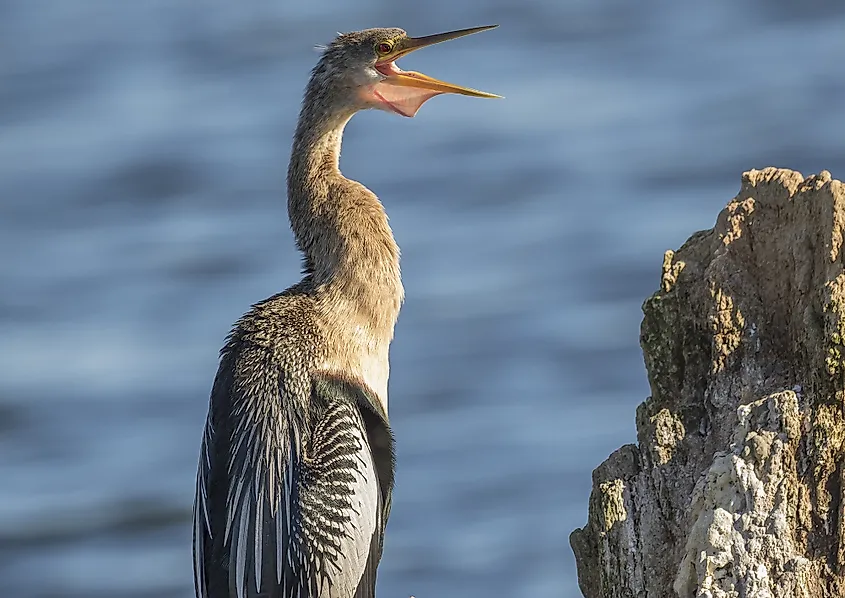
Nicknamed the "snakebird" for its serpentine neck, the anhinga (Anhinga anhinga) swims submerged in dark Everglades canals, only a sharp bill and sinuous head breaking the mirror surface. Lacking waterproof oils, its feathers soak, reducing buoyancy and allowing stealthy pursuit of gar, sunfish, and tadpoles. After each dive it perches with wings outstretched, drying on cypress snags like a living crucifix. Courtship displays flaunt turquoise eye rings and rattling crests, while loose stick nests balance above gator-guarded rookeries. Healthy flow regimes and pesticide restraint keep this elegant underwater spear-fisher part of the wetlands’ living mosaic for future generations to cherish.
Double-Crested Cormorant
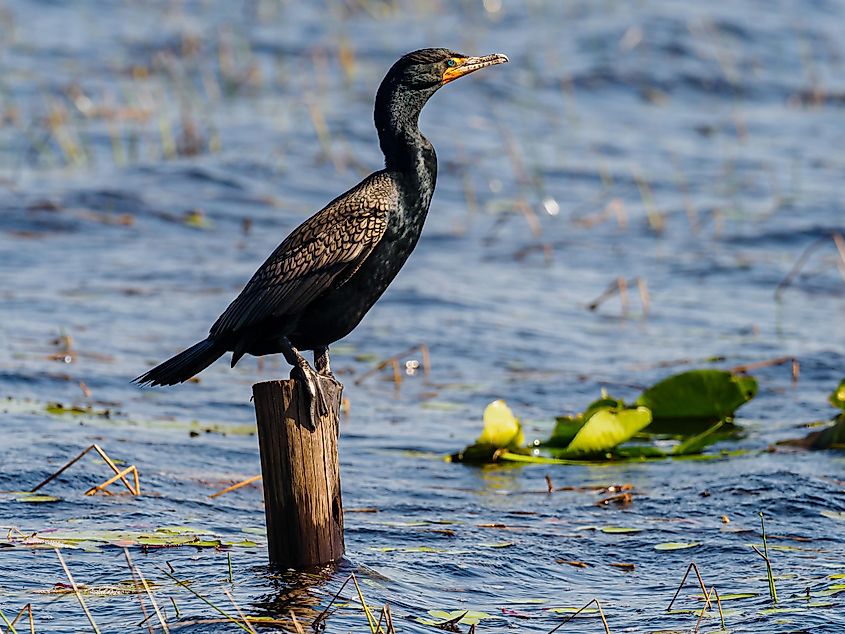
The double-crested cormorant (Nannopterum auritum), sooty-black and sleek, patrols Everglades waterways like a living torpedo. Skimming inches above the surface, it plunge-dives and chases mullet, catfish, and crayfish underwater, propelling with webbed feet and steering with a kinked neck. After hunting, the bird perches on mangrove roots, wings spread to dry waterlogged feathers that lack waterproof oils, a cruciform silhouette against saffron sunsets. In spring, adults flaunt twin tufted crests and turquoise eyes while weaving stick nests in communal rookeries with ibises and herons. Protecting clean water and undisturbed nest trees is essential for sustaining their numbers for future generations.
Red-Shouldered Hawk
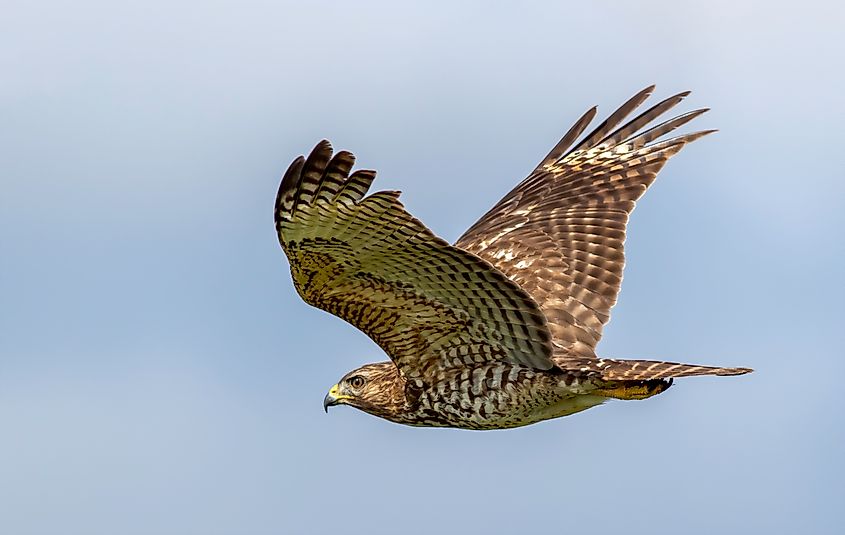
Whistling kee-aah calls slice humid air as the red-shouldered hawk (Buteo lineatus) patrols Everglades pinelands, swamp forests, and cypress strands. Rich rufous barring on chest and fiery epaulets flash while it weaves among trunks, tail banded black-and-white like river braids. From moss-draped perches it drops on crayfish, treefrogs, snakes, and marsh rats, balancing prey pulses. Monogamous pairs refurbish stick nests high in cabbage palms each January, lining them with Spanish moss and fresh pine sprigs. Protecting mature canopy corridors and unpolluted wetlands keeps this vigilant raptor broadcasting its wild whistle across South Florida skies every dawn and glorious pastel dusk.
Turkey Vulture
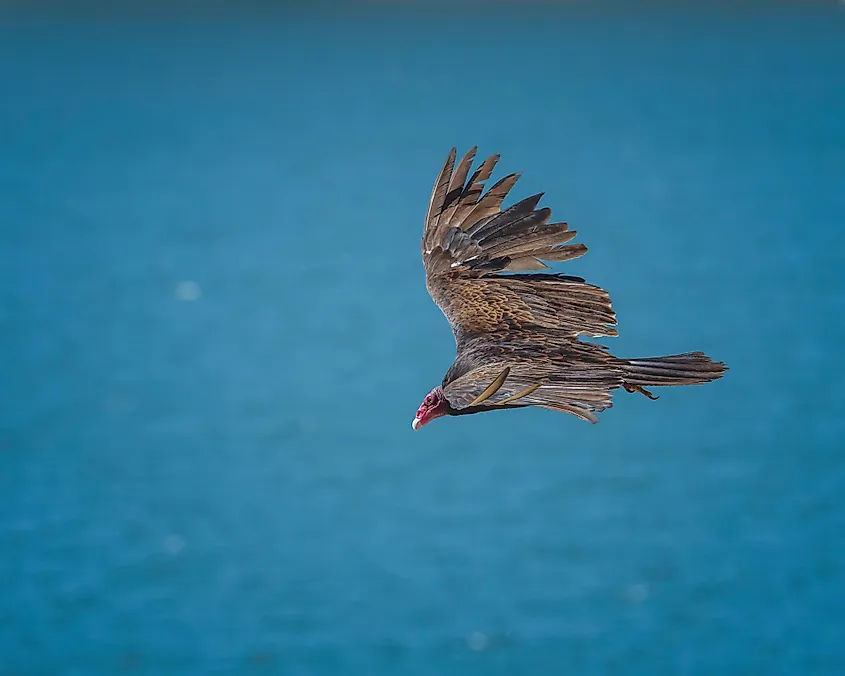
The turkey vulture (Cathartes aura) is the Everglades’ master scavenger. Its six-foot wings, held in telltale dihedral, wobble like a tight-rope walker as it sniffs carrion from miles away, thanks to an extraordinary olfactory bulb. Naked crimson head resists bacterial fouling while tearing decaying fish, deer, or gator remains that would otherwise pollute marsh water. Roosts form on cypress snags, where communal sun-bathing dries dew-damp feathers. Though resilient, vultures ingest lead fragments and microplastics left by humans. Safeguarding clean landscapes ensures these silent sanitizers continue recycling death into life across South Florida’s vast wetland cathedral forever.
Everglades Snail Kite
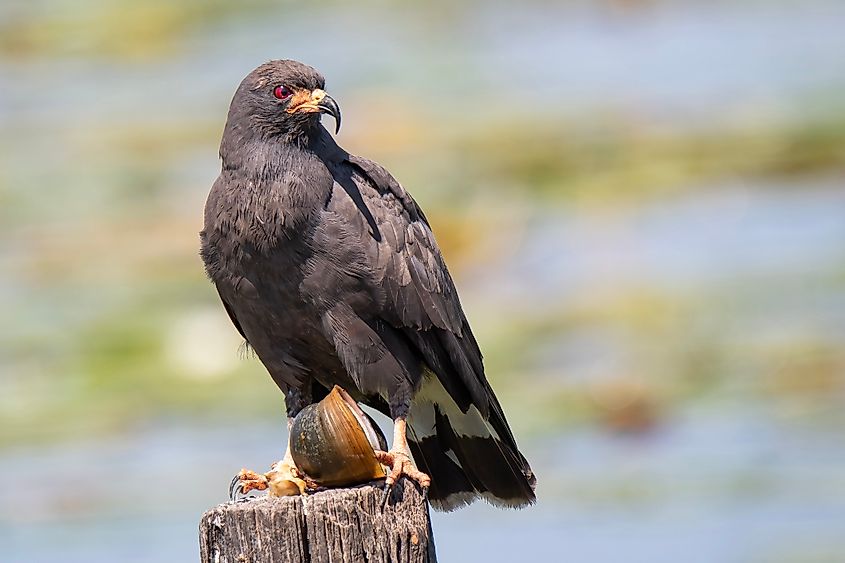
Slate-gray males and speckled brown females of the Everglades snail kite (Rostrhamus sociabilis plumbeus) hover low above sawgrass marshes, eyes locked on gleaming apple snails. A sudden stoop and their slim, sharply hooked beak extracts the soft body with surgical ease. With wings kiting against the wind they ferry shells to stick perches, littering rafts of pink-lipped empties. Successful nesting hinges on stable shallow water that exposes snail-laden lily pads. Drainage, drought, and herbicide loss of hydrilla shrink larders, yet invasive island apple snails now buoy brood sizes. Restored flow will decide this specialist raptor’s Everglades future and survival.
Limpkin
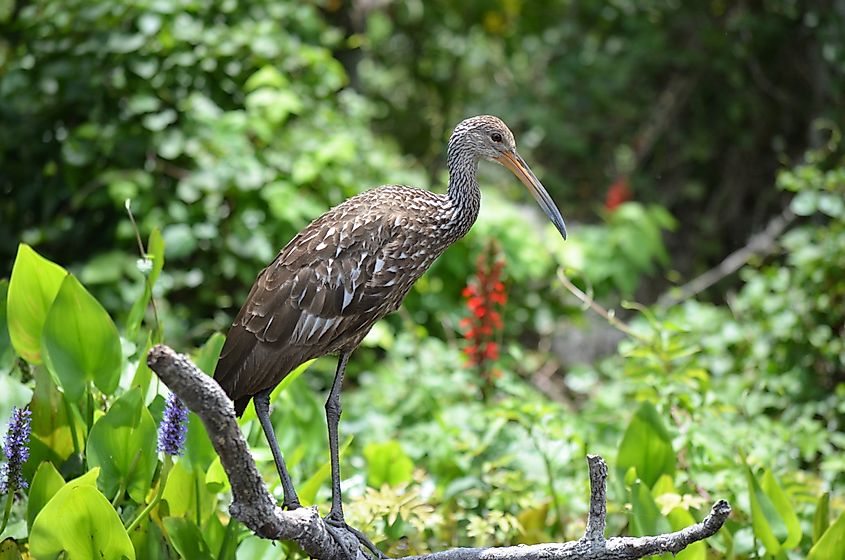
With a mournful scream echoing over twilight sloughs, the limpkin (Aramus guarauna) is the Everglades’ ghostly snail specialist. Cocoa-brown plumage speckled ivory blends with cattails as it wades shallow lagoons, probing with a long down-curved bill. Apple snails are pried from spiral shells using a subtle sideways twist, leaving neat opercula piles on floating logs. Monogamous pairs guard reed islands where stick nests cradle buff-spotted eggs, the male standing sentinel while the female broods. Because limpkin numbers rise and fall with water depths and snail abundance, restoring natural flow remains essential to keep their haunting calls threading the wetland night.
White Ibis
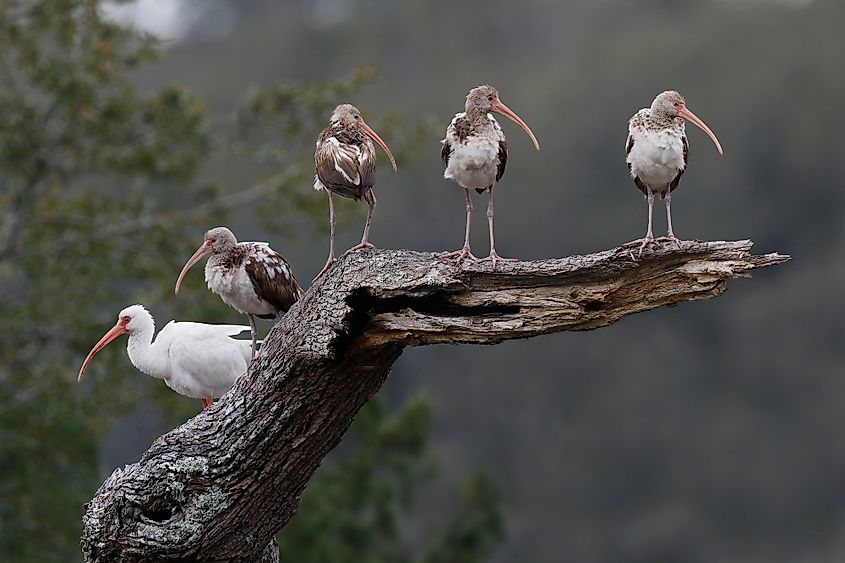
White ibises, snowy bodies contrasted by candy-red bills and legs, sweep through Everglades marshes in graceful, curving flocks. Using sensitive bill tips they probe mud and shallow water for crayfish, insect larvae, and small fish, snapping shut at the slightest touch. Their foraging paths aerate sediment and release nutrients, benefiting submerged vegetation. In late dry season they gather by thousands in pond apple or mangrove rookeries, weaving stick platforms above gator-guarded pools. Adults deliver boluses of regurgitated prey to chattering brown chicks. Maintaining pulsed water drawdowns and protecting feeding prairies sustain these gregarious wetland sentinels throughout South Florida's recovering river.
Cape Sable Seaside Sparrow
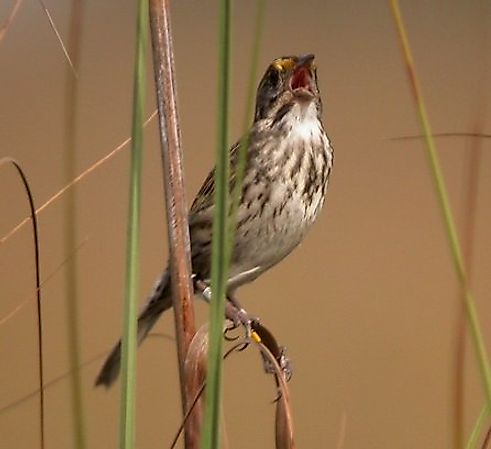
Endemic to the Everglades’ marl prairies, the Cape Sable seaside sparrow (Ammospiza maritima mirabilis) is the park’s most imperiled songbird. Males perch on sawgrass clumps at dawn, delivering rough buzzes likened to a dripping sprinkler. Nests, flimsy cups woven just five inches above the mud, must stay dry for 23 incubation days; mistimed water releases can drown clutches. Six isolated subpopulations together number fewer than 3,000 birds, threatened by sea-level rise, exotic cattails, and mammalian predators. Restoring natural hydroperiods and controlling vegetation are urgent actions if this tiny olive-gray sentinel is to continue measuring the Everglades’ pulse for scientists and future generations alike.
Bald Eagle
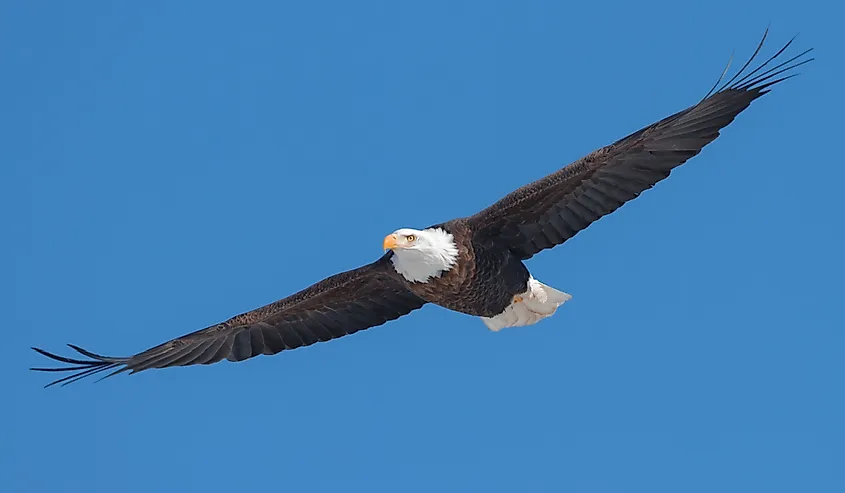
The bald eagle (Haliaeetus leucocephalus) commands Everglades skies with a seven-foot wingspan and piercing yellow eyes. These fish-eating raptors perch atop cypress sentinels, scanning tannin rivers for mullet, gar, or wounded waterfowl. In late fall, lifelong pairs refurbish massive stick aeries, some exceeding a metric ton, high in slash pines bordering open marshes. Downy eaglets hatch by January, nourished on regurgitated fish until adventurous fledging at twelve weeks. Mercury bioaccumulation, boat disturbance near nest trees, and shrinking foraging pools challenge populations, yet wetlands restoration and protective buffer zones keep America’s emblem soaring over South Florida’s wild mosaic.
Reptiles
American Alligator
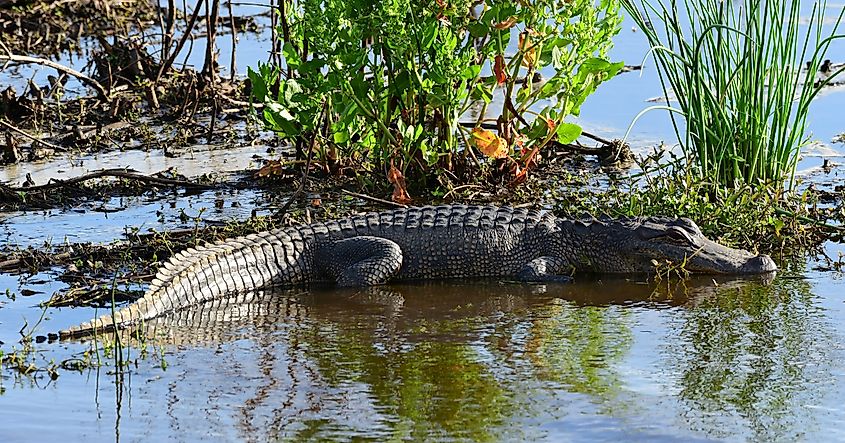
The American alligator (Alligator mississippiensis), armored in dark olive scales and ancient patience, reigns over Everglades sloughs, cypress domes, and marl prairies as both apex predator and indispensable engineer. Powerful jaws close with bone-splintering force on fish, turtles, birds, or unwary hogs, yet its excavated “gator holes” shelter countless drought-stranded fish and amphibians. Spring bellows reverberate through foggy dawns; females mound nests of sawgrass and peat whose rotting heat incubates ivory eggs. Hatchlings chirp, summoning maternal rescue to safer water. Poaching bans, water-quality improvements, and protected wetlands have restored populations, ensuring these living relics sculpt South Florida’s wetland heartbeat forever.
American Crocodile
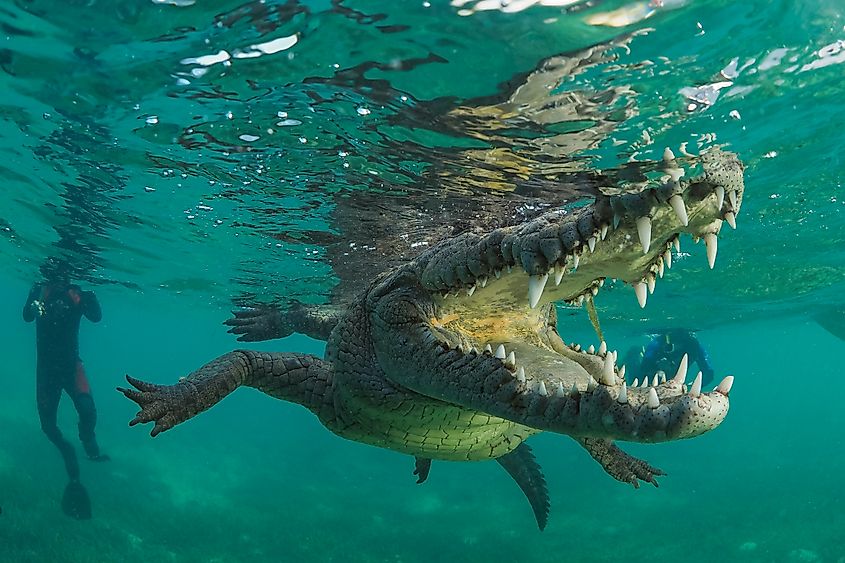
With a slender V-shaped snout and exposed fourth tooth, the American crocodile (Crocodylus acutus) haunts the Everglades’ brackish mangrove estuaries and turquoise Florida Bay creeks. Cold-sensitive, it basks on mudflats by day, slipping silently after mullet, tarpon, and blue crabs at dusk. Females pile sandy nests above spring high-tide, temperature deciding hatchling sex during June incubation. Once reduced below 300 animals by hunting and coastal development, numbers have rebounded above 2,000 under federal protection. Yet sea-level rise, canal discharges, and urban sprawl still imperil this salt-loving reptile, a living gauge of the Everglades’ fragile coastal heartbeat for generations to come.
Banded Southern Water Snake
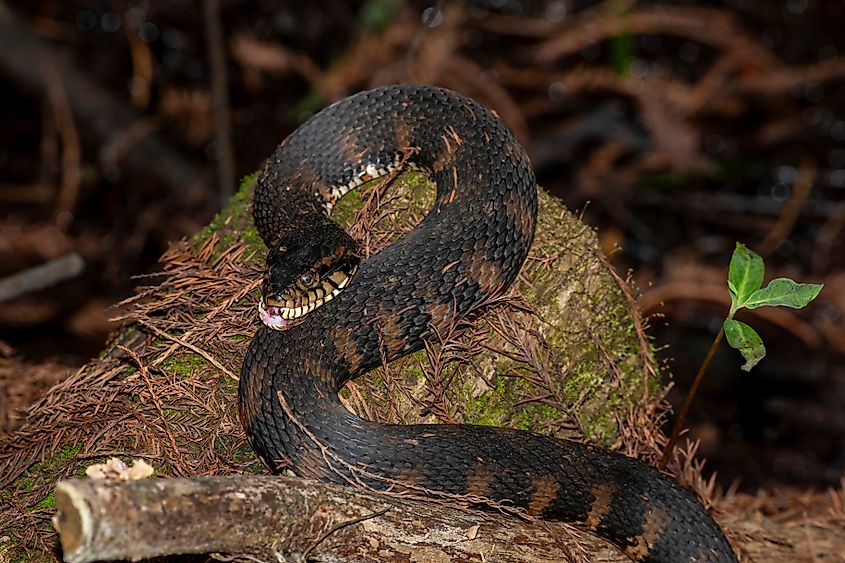
The banded southern water snake (Nerodia fasciata), blotched in alternating russet and dark chocolate saddles, coils through sawgrass canals and roadside ditches with confident vigor. Though non-venomous, it flattens its head and releases musk when cornered, frequently being misidentified as the formidable cottonmouth. Nocturnal summer hunts yield mosquitofish, sunfish, sirens, and treefrog tadpoles, which are swallowed alive and whole. Females birth thirty wriggling neonates each late summer, bypassing eggs entirely. During winter cool snaps, snakes bask atop tussocks or share crayfish burrows. Protecting clean, fish-rich waterways sustains this misunderstood predator, an essential link in the Everglades’ aquatic complex food web.
Florida Cottonmouth (Water Moccasin)
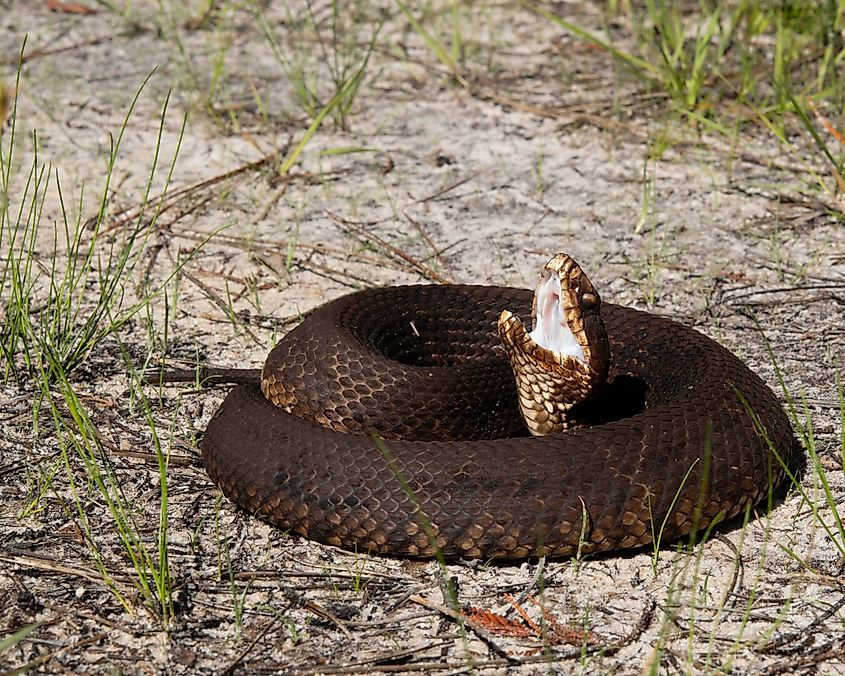
Stocky and dark-banded, the Florida cottonmouth (Agkistrodon conanti) rules shaded sloughs, cypress ponds, and mangrove margins with an infamous gape of ghost-white mouth. Heat-sensing pits guide night patrols for fish, frogs, young alligators, and carrion, making this pit viper a key wetland scavenger. When disturbed it coils, vibrates tail, and shows that cotton display before striking. Unlike water snakes, it swims high-bodied, head lifted clear. Females birth live litters of patterned neonates each summer upon floating debris piles. Road crossings, persecution, and hydrological change threaten numbers; conserving vegetated corridors lets this misunderstood sentinel keep Everglades food webs balanced and thriving.
Eastern Diamondback Rattlesnake
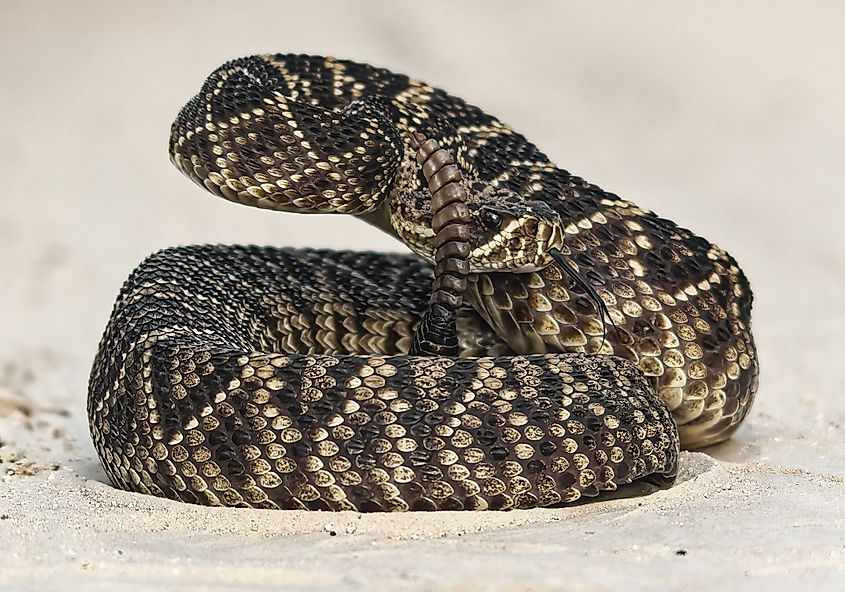
The eastern diamondback rattlesnake (Crotalus adamanteus) glides through Everglades pinelands, prairies, and hammock edges like living mosaic stone. Bold brown diamonds ringed in cream camouflage its thick three-to-six-foot body among saw palmetto shadows. Using heat-sensing pits, it ambushes cotton rats, marsh rabbits, and small wading birds, delivering potent hemotoxic venom before swallowing prey whole. The keratin rattle warns larger foes, yet persecution and vehicle strikes persist. Females bear live young every three years, leaving neonates to fend alone beneath dry fronds. Protecting upland refuges and educating visitors ensures this top reptilian predator continues regulating Everglades rodent populations.
Florida Softshell Turtle
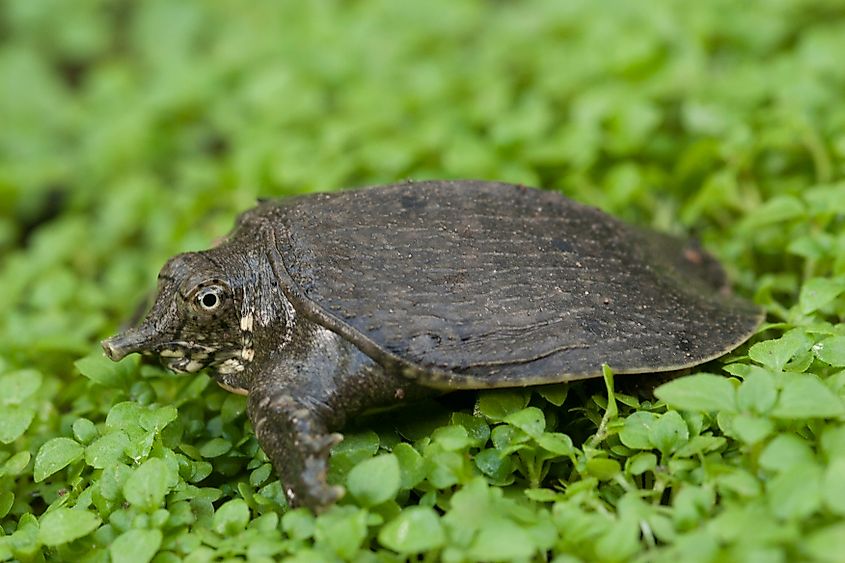
Flat as a leathery pancake, the Florida softshell turtle (Apalone ferox) prowls Everglades lakes, canals, and sloughs with snorkel-like nose breaking the surface. Ambush predator, it lunges from sandy bottoms for fish, crayfish, apple snails, and unlucky ducklings, drawing prey into a sharp-beaked mouth with vacuum speed. Limbs paddle swiftly, and skin replaces heavy scutes, granting agility on land for nesting. Females creep to sun-baked banks in spring, burying clutches exceeding twenty brittle eggs before returning to murky cover. Boat strikes, fishing hooks, and algal-fouled waters threaten populations; restoring clean flow and enforcing no-wake zones keeps this stealthy rover thriving.
Florida Snapping Turtle
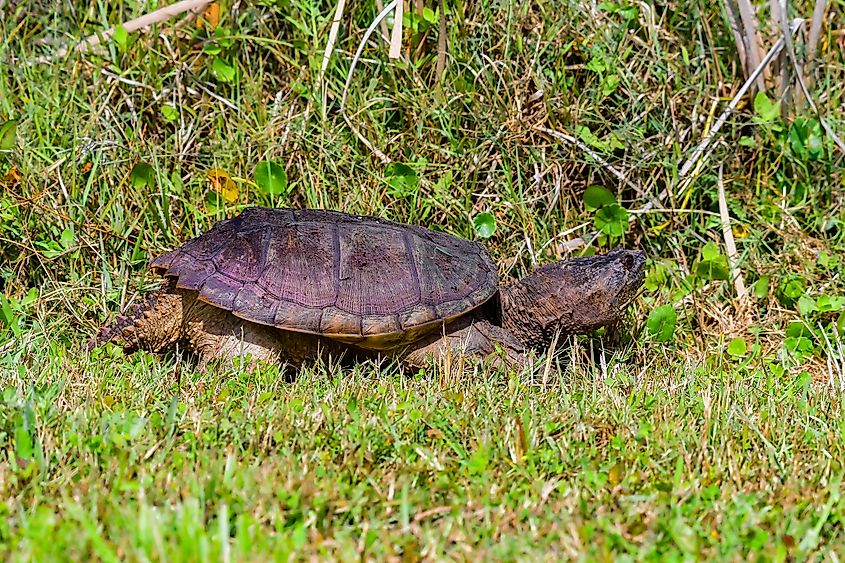
The Florida snapping turtle (Chelydra serpentina osceola), armored in algae-flecked ridges and sporting a prehistoric grin, lurks motionless in tannin pools beneath lily pads. At up to 45 pounds, it is the Everglades’ heavyweight ambush predator, inhaling fish, crayfish, ducklings, and carrion with lightning vacuum strikes. Needle-nosed nostrils break the surface like periscopes while powerful claws churn mud for camouflage burrows called wallows. From April to June females trek onto levees, depositing 20–40 ping-pong-sized eggs vulnerable to raccoons and flooding. Road mortality, water pollution, and illegal harvest threaten numbers; conserving clean wetlands ensures this ancient scavenger continues recycling life today.
Diamondback Terrapin
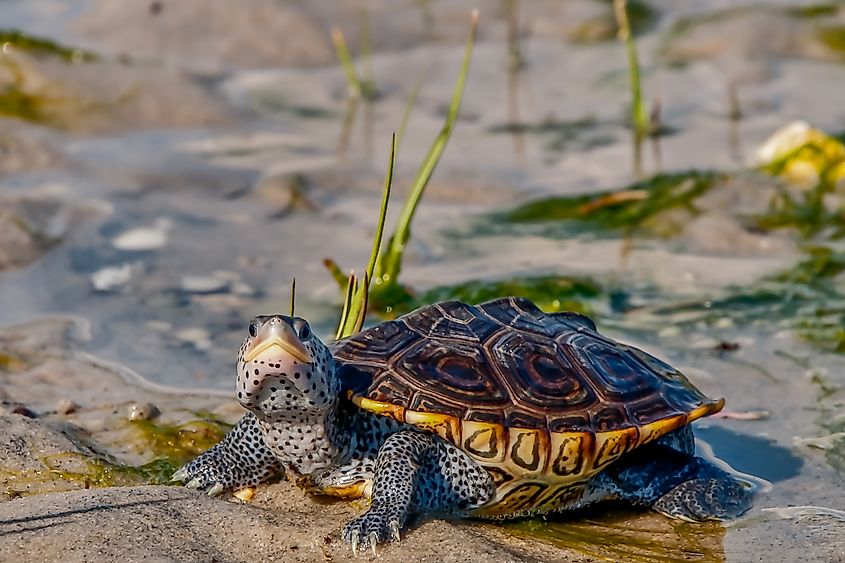
Diamond-patterned shell marks the diamondback terrapin (Malaclemys terrapin) cruising Everglades mangrove creeks and tidal flats where fresh and salt water mingle. Females, twice the weight of males, crack periwinkle snails, fiddler crabs, and small fish with crushing jaws, recycling calcium into the estuary. In early summer they crawl onto sun-baked spoil islands and dune edges, burying clutches of ping-pong-sized eggs above spring tides. Ghost crabs, raccoons, and storm surges claim many nests, while unmodified blue-crab pots drown adults. Bycatch reduction devices, habitat restoration, and sea-level defenses safeguard this sentinel’s future and strengthen Everglades biodiversity.
Loggerhead Sea Turtle
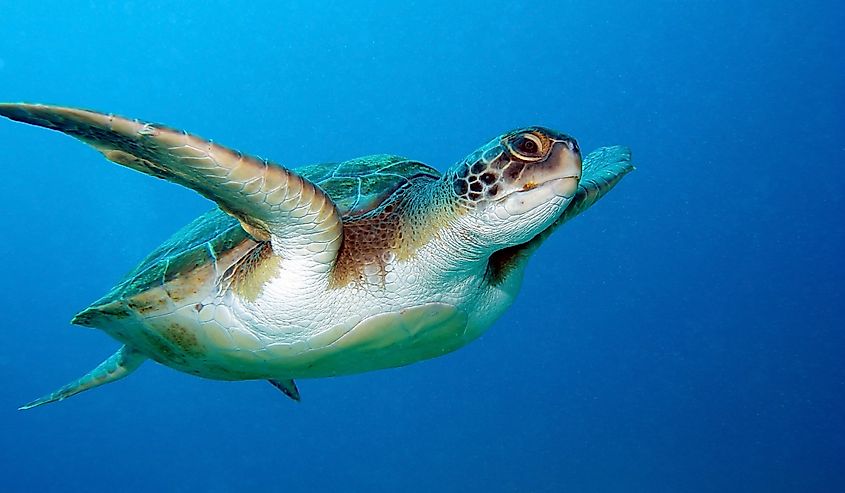
The loggerhead sea turtle (Caretta caretta) hauls onto South Florida’s ocean-facing beaches each summer to nest, yet forages within the Everglades’ Gulf estuaries the rest of the year. Females scoop pits above the spring high-tide line, depositing about 110 ping-pong-sized eggs, their sex set by sand temperature. After two months, hatchlings scramble toward surf guided by moonlit horizons. Adults cruise seagrass beds and patch reefs, crushing conchs, horseshoe crabs, and whelks with massive jaws. Coastal lighting, shrimp-trawl by-catch, plastic debris, and rising seas threaten survival; darkened shorelines and turtle-excluder devices keep this ancient mariner gliding past mangroves.
Amphibians
Little Grass Frog
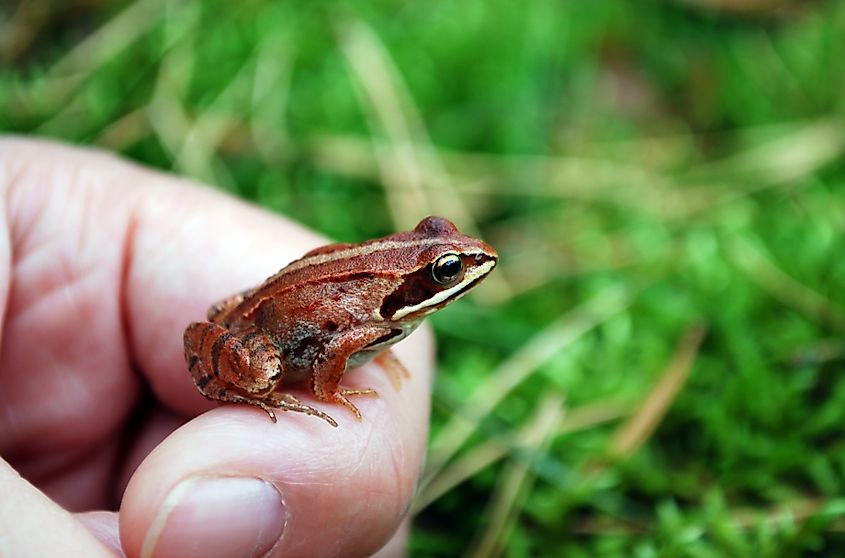
At scarcely longer than a paperclip, the little grass frog (Acris gryllus) is the Everglades’ tiniest vertebrate voice. Olive or reddish-brown, with a dark mask through the eye and a bronze dorsal stripe, it leaps prodigiously, over 20 times its 1.5-centimeter body length, between clumps of sawgrass and sphagnum. Males gather in rain-filled depressions, their delicate tink-tink chorus reminiscent of distant sleigh bells and audible after summer thunderstorms. Eggs adhere to submerged vegetation and tadpoles metamorphose within four weeks, racing seasonal dry-downs. Maintaining shallow wetlands free of pesticides preserves this miniature amphibian, a subtle indicator of hydroperiod health and overall ecosystem purity.
Oak Toad
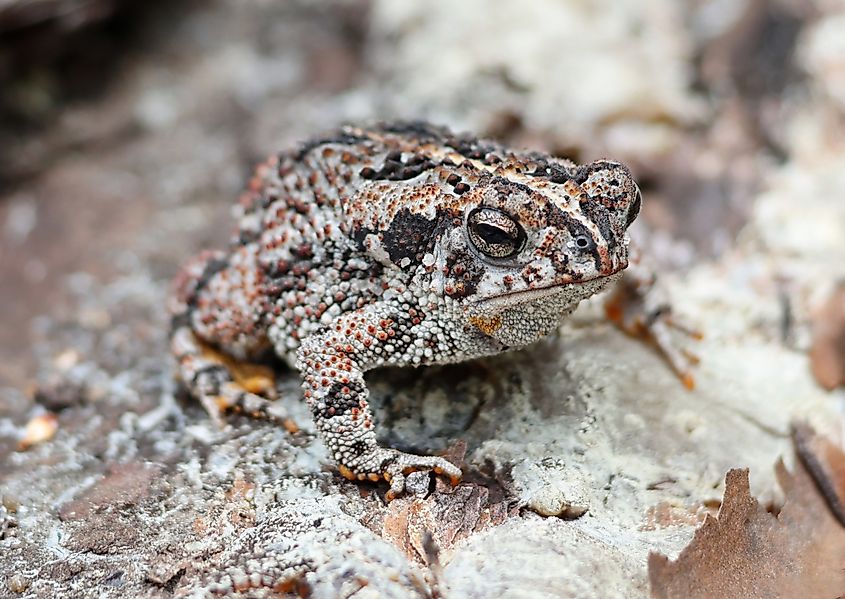
Palm-sized yet loud, the oak toad (Anaxyrus quercicus) is North America’s smallest toad and a diminutive resident of Everglades pine flatwoods and wet prairies. A pale racing stripe bisects a rough, charcoal-speckled back, while a chick-like “peep” chorus erupts after summer cloudbursts. Rain triggers explosive breeding in shallow, tea-colored puddles; females lay delicate gelatin strings, and black-tadpoled swarms metamorphose in three swift weeks before puddles vanish. The day finds adults burrowed under sand or leaf litter, emerging at dusk to nab ants and tiny beetles. Protecting ephemeral ponds and fire-maintained uplands keeps this pocket-size sentinel chirping across South Florida wetlands.
Pig Frog
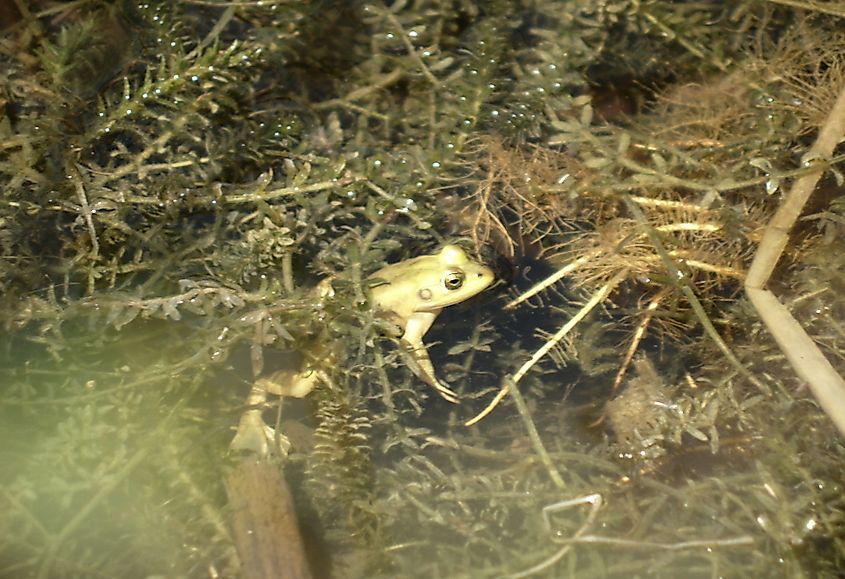
Deep croaks likened to distant pigs give the pig frog (Lithobates grylio) its name across Everglades sloughs and alligator holes. Olive bodies mottled with dark blotches float just eyes and nostrils above water, hind limbs poised for vaulting leaps exceeding six feet. Nocturnal ambushes net crayfish, small fish, snakes, and even other frogs, swallowed whole by gaping jaws. Males call all summer from emergent vegetation; gelatinous egg masses, sometimes 10,000 strong, carpet sheltered shallows and hatch within days. Wetland drainage, herbicide drift, and chytrid fungus threaten populations, yet restoring clean, consistent water levels secures this boisterous amphibian’s future chorus forever.
Green Tree Frog
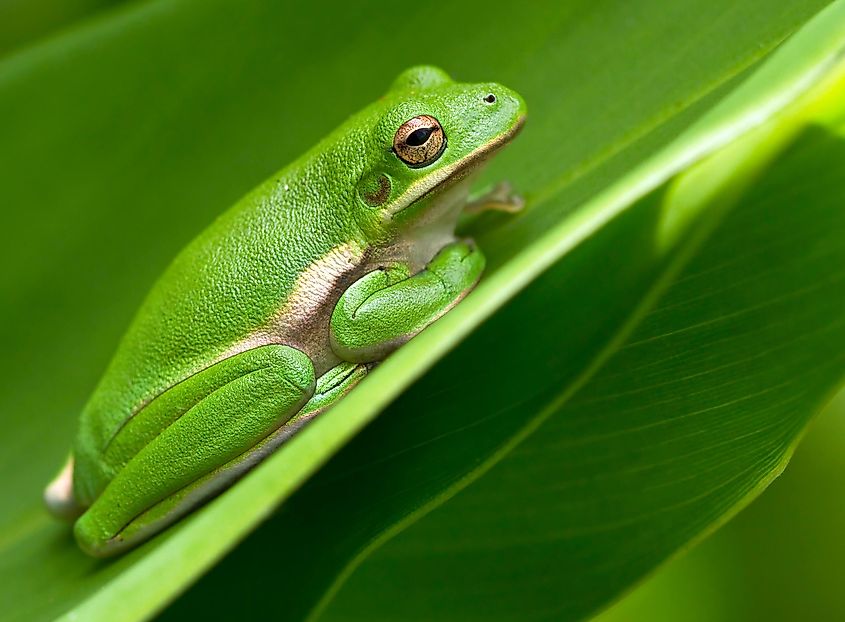
The green tree frog (Hyla cinerea) brightens Everglades hammocks, sawgrass margins, and suburban porches alike. A slender insect-hunter, it clings to cattail blades with toe pads secreting sticky mucus and lunges at moths, mosquitoes, and midges under night-falling floodlights. Males chorus with resonant quonks during humid evenings, choosing resonant hollow stems to amplify voices that attract receptive females. Eggs, scattered on floating vegetation, hatch in days, and tadpoles metamorphose within two months of warm water. Pesticide drift, habitat fragmentation and saltwater intrusion threaten their cheery calls; restoring flow keeps this tiny arboreal ambassador alive.
Fish and Rays
Florida Gar
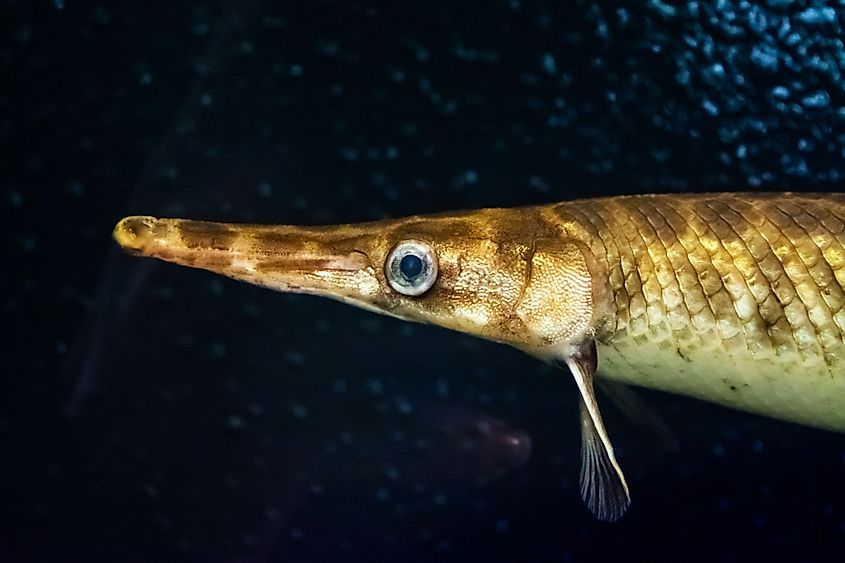
Sheathed in iridescent, armor-like ganoid scales, the Florida gar (Lepisosteus platyrhincus) patrols Everglades canals, sloughs, and cypress ponds like a living spear. Hovering motionless, it suddenly lunges with a long, tooth-lined snout to impale minnows, crayfish, and insect larvae, helping balance aquatic communities. A lung-like gas bladder lets it gulp air, surviving warm, low-oxygen shallows that defeat most fish. Each February–April, adults scatter adhesive, toxic eggs among flooded grasses; striped juveniles cling to stems until swimming freely. Pollution, altered water flow, and invasive armored catfish threaten this 100-million-year relic, whose survival signals healthy, slow-moving Everglades waterways and future wetland biodiversity.
Tarpon
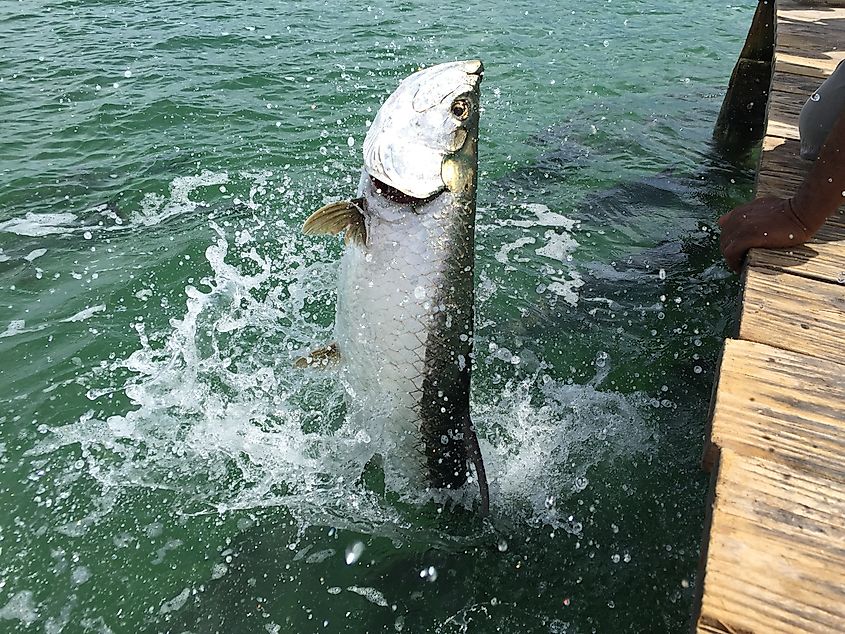
The tarpon (Megalops atlanticus) prowls the Everglades’ mangrove labyrinth with rolling gulps that betray its presence. Able to inhale atmospheric oxygen through a lung-like swim bladder, it thrives in stagnant backwaters avoided by other fish. Juveniles, called “fat sleepers,” shelter in tannin pools before migrating seaward. Adults, exceeding 200 pounds, launch skyward in acrobatic leaps when hooked, thrilling anglers and scattering mullet schools. Spring moon tides trigger upstream spawning runs, releasing millions of drifting eggs. Habitat loss, cold snaps, and pollution imperil stocks; protecting nursery wetlands ensures legendary silver kings keep patrolling Florida’s watery wilderness.
Smalltooth Sawfish
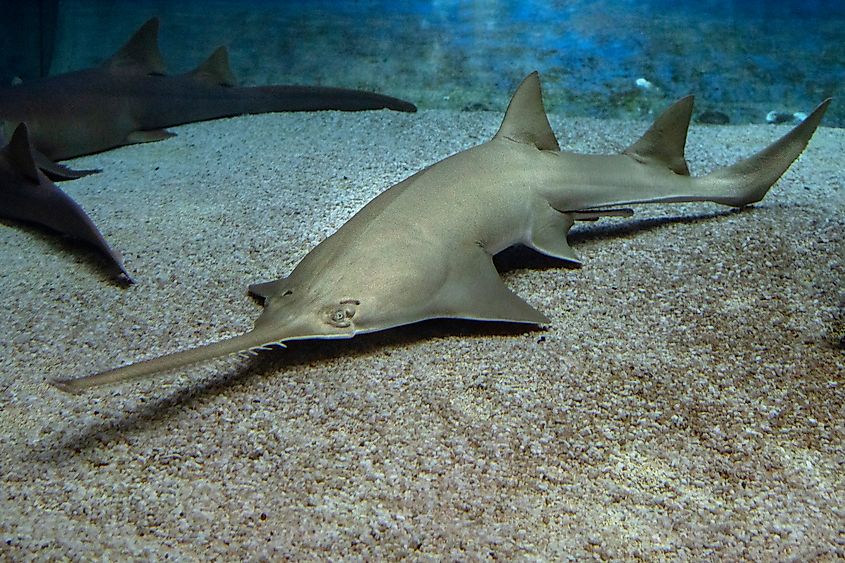
Gliding silently through turbid channels, the smalltooth sawfish (Pristis pectinata) brandishes a chainsaw-like rostrum edged with dagger teeth. Electro-receptors on that snout detect mullet, stingrays, and crustaceans buried in mangrove mud; a quick side swipe stuns prey. Newborns, already two feet long, are birthed live in late spring within sheltered Everglades creeks where tannin water hides them from sharks. Adults may exceed sixteen feet, favoring shallow bays less than three meters deep. Coastal development, gill-net bycatch, and propeller strikes slashed populations to under 5 % of historical levels. Protected nursery zones and rostrum-free fisheries gear now offer fragile hope for recovery.
Invasive Animal Species
The Florida Everglades faces a diverse onslaught of invasive animals that threaten its iconic and fragile wetland ecosystem. Tiny invertebrates such as the fast-breeding Asiatic clam, bromeliad beetle, and lobate lac scale clog waterways and ravage native bromeliads and woody plants. Aquatic invaders like suckermouth and walking catfish, blue tilapia and Mayan cichlid out-compete native fish, erode food webs, and even injure birds.
Reptiles pose the most visible menace: Cuban knight anoles displace native lizards; green iguanas undermine levees; tokay geckos raid nests; and giants, including Burmese pythons, green anacondas, Nile monitors, and Argentine black-and-white tegus, consume everything from eggs to deer, driving some mammal populations down 90 percent.
Two invasive birds add further pressure: Muscovy ducks spread disease and hybridize, while monk parakeets build communal nests that may crowd native fauna. Long-established mammals intensify the damage; wild boars root up soil and transmit pathogens, feral cats completely decimate small vertebrates, and black rats compete with endangered woodrats. Most of these species arrived via the pet trade, aquaculture escapes, or early colonial ships, and with few natural predators, they expand rapidly. Their combined impacts fragment habitats, spread disease, and severely destabilize delicate native communities, making coordinated control and public awareness programs essential.
From apex predators such as the Florida panther to filter-feeding manatees, the animals highlighted here form the ecological scaffolding of the Everglades. They sculpt vegetation, move energy between land and water, and signal the wetland’s health to scientists who track population trends, mercury loads, and shifting hydroperiods. Yet they represent only a fraction of the park’s living catalogue: hundreds of additional invertebrates, fishes, amphibians, birds, and mammals, many still unnamed or poorly studied, perform equally vital services in hidden sloughs and tree-island hollows. Safeguarding this broader biota demands restoring natural freshwater flows, curbing nutrient runoff, and controlling invasive species that unravel food webs. Ongoing telemetry, genomic, and remote-sensing work are clarifying migration corridors and thermal refuges, providing actionable targets for managers. With sustained research, policy support, and public vigilance, the Everglades can continue to pulse with its full, intricate menagerie for centuries to come, if we act decisively now.











